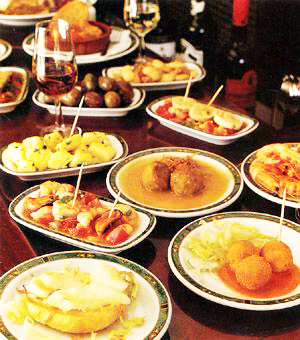

If you have visited Spain, or have friends who have come on holiday it is most likely that you have heard of tapas. A tapa is an appetizer served in most bars with alcoholic or non alcoholic beverages, so tapas y cañas (a small glass of draft beer) has become an identity sign in Spain. There is even a verb: tapear, which means basically have dinner based on the tapas served with your drink.
The name tapa (which means lid or cover) comes from the fact that in the past a glass of wine or ale was covered with a slice of bread or ham to avoid flies drowning in the drinks. Nowadays tapas can be anything, a small sandwich like appetizer, a small portion of salad or dish. Many bars and taverns have their own hallmark tapas or a very specialized tapas menu.
The size of tapas depend on the region and the bar, but it is possible to dine entirely on them. In some regions the tradition is waning, and they'll serve nuts or crisps instead of the tapa. If you want the traditional tapas y cañas experience we recommend you ask the locals for the best tapas bar. In many cities there are a number of bars that are famous for their tapas, and sometimes, tour guides and information centres will offer maps showing a tapas route for people to follow. This is a great way to see more of a Spanish city at the same time as enjoying some great Spanish food.
There are a number of different variations of tapas as well, each with their own name. Especially in the northern regions of Spain, such as Asturias, Cantabria and Navarra, you will find tapas in the form of pinchos, or pintxos as they are called in the Basque language. It is customary for bars to sell all their pinchos at the same price. Pinchos tend to be more elaborate than your avergae tapas.
Tapas are almost always served cold. It is only in certain provinces that they are served warm. In provinces such as Ávila, Segovia and Cáceres, some of the classic warm tapas include como croquetas which are like croquettes, baguettes, calamares a la romana, tortilla española (Spanish omelette), stuffed peppers etc. These tapas are served warm as they normally don't have a larger version that can serve as a main dish.
Should you ever visit Spain you will be a witness of this typical Spanish tradition. It is a great way to enjoy a whole range of the dishes in Spanish gastronomy without getting too full. Furthermore, tapas are great to share between friends, so why not go out and try some with your fellow classmates from your Spanish language school.
There can be no doubt about the fact that tapas have become one of the most identifiable images of Spain and Spanish cooking. Plus, they are not just confined to Spanish bars, but have a high status and presence in much more formal settings. They often served at meetings and conferences of dignataries and politicians in Spain. Furthermore, they have become very popular amongst some of the more upmarket restaurants in Spain where they often served as appetizers of starters. One of the forerunners in this field is the Spanish chef Ferran Adrià.
Thanks to their popularity, Spanish tapas dishes have also made it across the world in a number of different countries. There are a number of Spanish and Latin American restaurants that serve tapas dishes across the world, particularly in the UK. Although, many of the dishes are based on true Spanish dishes, they have often been adapted for different palates. Therefore, the only true Spanish tapas experience you can have will be in Spain!
Below is a list of links which will take you to our pages on some of the most popular Spanish tapas. On these pages, you can find out more about the history and origins of the dishes, as well as find some quick and easy recipes to follow so that you can make some at home. You could always organise a Spanish tapas party at home and serve these dishes as part of your menu!